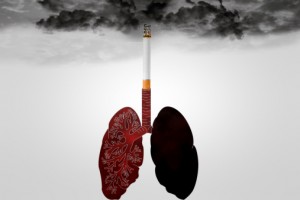

 Pneumonia and lung cancer both affect the lungs, but while the former is easily treatable and the latter is oftentimes life threatening. Different types of pneumonia can occur in lung cancer patients – who are more susceptible to the infection – complicating the course of the disease and prolonging the recovery. Both illnesses may begin the same symptomatically, with a cough and mucus, but they take vastly different pathological courses.
Pneumonia and lung cancer both affect the lungs, but while the former is easily treatable and the latter is oftentimes life threatening. Different types of pneumonia can occur in lung cancer patients – who are more susceptible to the infection – complicating the course of the disease and prolonging the recovery. Both illnesses may begin the same symptomatically, with a cough and mucus, but they take vastly different pathological courses.
Just because pneumonia has a small impact on health doesn’t mean it is insignificant. In fact, out of all deaths in children under five years old, 15 percent can be attributed to pneumonia. That figure adds up to 922,000 deaths for 2015. Worldwide, pneumonia is still the largest cause of death for children within that age range.
The reason so many children die due to pneumonia is because less than one third actually get the antibiotics needed to fight the symptoms. Sub-Saharan Africa and South Asia make up the bulk of these deaths, with children being infected through airborne virus particles. However, pneumonia can also be spread through the blood, commonly taking place during birth in these regions.
Estimates for the U.S. lung cancer cases for 2016 are 224,390 new diagnoses and 158,080 deaths. Lung cancer is the leading cause of cancer death. Annually, more people die from lung cancer than colon, breast, and prostate cancers combined.
Lung cancer is mainly diagnosed in seniors over the age of 65, with less than two percent of diagnoses occurring in those younger than 45.
 Pneumonia vs. lung cancer: Signs and symptoms
Pneumonia vs. lung cancer: Signs and symptomsSome of the pneumonia symptoms overlap with those of the cold, but the condition also has discerning symptoms of its own. Some symptoms of pneumonia include the following:
Again, any combination of these symptoms likely indicate you have the pneumonia. These symptoms may mimic a cold, but in case of pneumonia it’s important that you treat these symptoms immediately to prevent any more serious consequences.
The main symptoms of lung cancer are:
Less common symptoms of lung cancer include:
Pneumonia can be caused by the same viruses and in the same manner as a common cold or flu – that is, virus droplets in the air or hand touching. If the virus remains in the nose and throat area, it only develops into a cold. However, if it reaches down to the lungs, then it causes pneumonia, which is a greater threat to your body.
Besides the above, mycoplasma bacterium is another cause of pneumonia. Mycoplasma pneumonia is sometimes referred to as “walking pneumonia” because of its mild effects. People with this form of pneumonia are not bedridden and can, in fact, walk around as if they are healthy.
More severe types of pneumonia can actually be caused by bacteria already in your throat. In most instances, the immune system usually takes care of these bacteria and keeps them at bay, so the infection doesn’t spread anywhere else. But when the immune system is compromised for any reason – cold, cancer treatment, etc. – these bacteria can find their way to the lungs and cause pneumonia.
Majority of lung cancer cases are a result of smoking, which is associated with 85 percent of the incidences. Tobacco contains over 60 different toxins that could lead to the development of cancer. If you smoke over 25 cigarettes a day, you are 25 times more likely to develop lung cancer.
Other products that increase a person’s risk of lung cancer are cigars, pipe tobacco, snuff, and chewing tobacco. Smoking cannabis has also been associated with lung cancer. The problem here is, although cannabis users smoke less, they either mix cannabis with tobacco or they hold smoke in their lungs for longer periods of time.
Even passive smoking or second-hand smoke can increase a person’s risk of lung cancer. Studies have shown that non-smoking women who share a household with a smoking partner still have a 25 percent higher risk of developing lung cancer, compared to women in non-smoking households.
Occupational exposures that can cause cancer include arsenic, asbestos, beryllium, cadmium, coal and coke fumes, silica, and nickel.
 There are several different types of pneumonia.
There are several different types of pneumonia.
Bacterial pneumonia can be caused by different types of bacteria, including streptococcal pneumonia (most common in adults), chlamydophila pneumonia, and H. influenza type B pneumonia (most common in children).
The common signs and symptoms of bacterial pneumonia include high fever, cough with phlegm, chills, chest pain when breathing or coughing, rapid breathing, shortness of breath, and loss of appetite.
Bacterial pneumonia is very contagious, so getting on an antibiotic treatment right away can reduce your contagiousness.
Walking pneumonia is a milder form of pneumonia that presents symptoms similar to a cold. Those symptoms include low-grade fever, persistent dry cough, fatigue and tiredness, shortness of breath, chest pain, and loss of appetite. Walking pneumonia is less severe than full-blown pneumonia, yet it can still be passed on through droplet transmission. Steering clear of others can help reduce transmission of the infection, along with covering your mouth and nose when coughing or sneezing.
Viral pneumonia is caused by a virus and commonly affects children. Viral pneumonia may clear up within three weeks, but does increase the risk of bacterial pneumonia. Symptoms of viral pneumonia are similar to the flu with fever, aches, and cough. Symptoms may worsen within the first two days, then proceed to improve. Viral pneumonia is highly contagious and can actually spread quicker than bacterial or fungal pneumonia.
Fungal pneumonia comes in three subtypes of fungal pneumonia: coccidioides, histoplasma, and cryptococcus. A person with a weakened immune system can get sick by inhaling a fungus. Symptoms include fever, dry cough, fatigue, and shortness of breath. Unlike other types, fungal pneumonia is not contagious, but symptoms may appear worse in those with weaker immune systems.
Aspiration pneumonia occurs when a person inhales food or other objects into their lungs. Although not contagious, aspiration pneumonia can be life threatening, so immediate medical attention is required.
There are three main types of lung cancer: non-small cell lung cancer, small cell lung cancer, and lung carcinoid tumor.
Non-small cell lung cancer is the most common type of lung cancer accounting for 85 percent of cases.
Small cell lung cancer is seen in 10 to 15 percent of lung cancer cases. This type of lung cancer tends to spread quite quickly.
Lastly, lung carcinoid tumor is only seen in fewer than five percent of lung cancer cases. In this type, the tumor grows slowly and rarely spreads.
Anyone can catch pneumonia, but certain groups may be at a higher risk to develop the respiratory condition than others. Pneumonia is commonly seen in older children and adults under 40. Individuals residing in crowded areas like schools, prisons, and shelters are at a higher risk of walking pneumonia. Smokers and those with chronic illness or a weakened immune system are also at a greater risk for contracting pneumonia.
Risk factors for pneumonia include being a smoker, having a recent viral infection, experiencing difficulty swallowing (due to stroke or other health condition), having chronic lung diseases, cerebral palsy, or another serious illness like heart disease or cirrhosis, living in a nursing facility, having impaired consciousness, recovering from a recent surgery or trauma, or having a weakened immune system.
Complications of pneumonia include difficulty breathing, bacteria entering the bloodstream causing a worsened infection, fluid accumulation around the lungs, and lung abscess where pus forms in the lung cavity.
Risk factors for lung cancer include smoking, second-hand smoke, exposure to radon gas, exposure to occupational chemicals, and a family history of lung cancer.
Lung cancer complications include shortness of breath, coughing up blood, pain, fluid in the chest, and cancer spreading to other parts of the body.
 For pneumonia, doctors will check to see if your glands are swollen and test your temperature for a fever. Since pneumonia takes place in the lungs, they will use a stethoscope to listen to your breathing. A blood test will also be able to determine whether you have pneumonia, and X-ray will show any buildup of fluid in the lungs.
For pneumonia, doctors will check to see if your glands are swollen and test your temperature for a fever. Since pneumonia takes place in the lungs, they will use a stethoscope to listen to your breathing. A blood test will also be able to determine whether you have pneumonia, and X-ray will show any buildup of fluid in the lungs.
When it comes to treating pneumonia, following the directions to the exact specifications is important. People tend to want to stop taking any prescriptions or lighten their dose as they begin to feel better. But this is not advisable. Take the medication for as long as your doctor has instructed.
Preventing pneumonia can be done effectively through diet. Eating a balanced diet that includes plenty of fruits and vegetables is a great start. Getting lots of rest is also beneficial and helps keep your immune system strong. Vaccination is also a great idea and something everyone should do, particularly around cold and flu season. We’ve already mentioned the importance of hand washing, which prevents the bacteria from spreading, but if you notice that you have a cough or are feeling off for more than three or four days, then go see your doctor.
Lung cancer is diagnosed through a series of imaging tests including chest X-rays, CT scans, and PET-CT scans. These tests allow your doctor to have a look into the lungs to check for tumor growth or anything else that could be causing your symptoms, such as fluid in the lungs.
Your doctor will also perform a biopsy to check the extracted tissue for cancer.
Once testing is completed, the doctor will be able to stage the cancer. Stage 1 cancer means the cancer is contained to the lungs and the tumor is either less than three cm, or between three and five cm.
Stage 2 is divided into two categories. In the first, the tumor is sized between five and seven cm, and in the second, the tumor is larger than seven cm. Stage 2 means the cancer has begun to spread to surrounding lymph nodes.
In stage 3, the cancer has spread further and tumor growth is larger as well.
Lastly, stage 4 lung cancer has spread to both lungs, as well as other body parts, including bones and organs.
The treatment you receive for your lung cancer depends on the type and the stage. Treatment for non-small lung cancer often involves surgery to remove cancer cells, along with chemotherapy to destroy any other cells that may not have been removed.
In small-cell lung cancer, treatment usually involves chemotherapy, often combined with radiotherapy. Because cancer has spread, surgery is often not an option unless the tumor has been found early on.
Types of surgery to treat lung cancer include lobectomy – parts of the lungs are removed, pneumonectomy – the entire lung is removed, and wedge resection where only a small piece of the lung is removed.
In COPD patients, pneumonia survival in hospitals improved with inhaled corticosteroids: Study
In COPD patients, pneumonia survival in hospitals is improved with inhaled corticosteroid treatment. The findings of the study uncovered that lower in-hospital mortality was seen in chronic obstructive pulmonary disease (COPD) patients who received a combination of long-acting inhaled bronchodilators (IBD) therapy and corticosteroids, compared to patients on IBD alone. Continue reading…
Is pneumonia contagious? Types and symptoms of pneumonia
If you ever wondered whether pneumonia is contagious, we are here to address your concerns. First of all, pneumonia is inflammation of the lung tissue, caused by a virus, bacteria, or fungus. In pneumonia, the air sacs become filled with pus. Continue reading…
Sources:
http://www.belmarrahealth.com/walking-pneumonia-vs-pneumonia-differences-in-symptoms-causes-and-treatment/
http://www.belmarrahealth.com/is-pneumonia-contagious-types-and-symptoms-of-pneumonia/
http://www.cancer.org/cancer/lungcancer-non-smallcell/detailedguide/non-small-cell-lung-cancer-key-statistics
http://www.cancer.org/cancer/lungcancer/
http://www.nhs.uk/Conditions/Cancer-of-the-lung/Pages/Diagnosis.aspx
Copyright © www.orthopaedics.win Bone Health All Rights Reserved